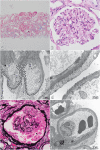Spectrum of podocytopathies in new-onset nephrotic syndrome following COVID-19 disease: a report of 2 cases
- PMID: 32753052
- PMCID: PMC7401468
- DOI: 10.1186/s12882-020-01970-y
Spectrum of podocytopathies in new-onset nephrotic syndrome following COVID-19 disease: a report of 2 cases
Abstract
Background: Coronavirus disease-2019 (COVID-19) is an ongoing pandemic which has affected over 12 million people across the globe. Manifestations in different organs systems are being reported regularly. Renal biopsy findings in hospitalized COVID-19 patients presenting solely with acute kidney injury (AKI) have recently been described in published literature in few case reports. The findings include diffuse acute tubular injury (ATI) along with the glomerular lesion of collapsing glomerulopathy (CG). However, nephrotic syndrome as the presenting complaint of COVID-19 has not been reported widely, neither has any other glomerular lesion other than CG.
Case presentation: We describe the kidney biopsy findings of two patients who had recent diagnoses of COVID-19 and presented with new-onset nephrotic syndrome. Renal biopsy in both patients showed ATI (as in previous reports) and distinct glomerular findings on light microscopy - that of minimal change disease (MCD) initially in one patient followed by CG in a subsequent biopsy and CG at the outset in the other patient. The electron microscopic findings in both patients were that of severe podocytopathy (diffuse and severe podocyte foot process effacement).
Conclusion: Our cases highlight a novel clinical presentation of COVID-19 renal disease, not described before, that of new-onset nephrotic syndrome. While all published case reports describe CG as the glomerular pathology, we describe a non-CG pathology (MCD) in one of our cases, thereby adding to the repertoire of renal pathology described in association with COVID-19 patients. However, the exact mechanism by which podocyte injury or podocytopathy occurs in all such cases is still unknown. Optimal treatment options for these patients also remains unknown at this time.
Keywords: COVID-19; Collapsing glomerulopathy; Nephrotic syndrome; Podocytopathy.
Conflict of interest statement
All authors declare that they have no competing interests.
Figures


References
Publication types
MeSH terms
LinkOut - more resources
Full Text Sources

